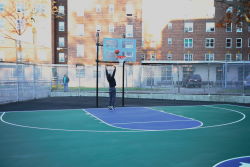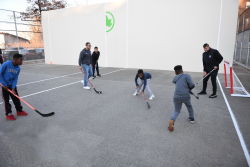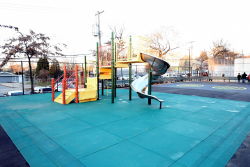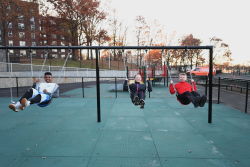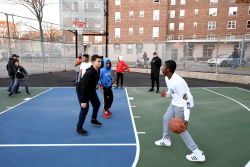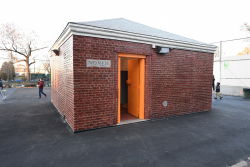Christopher J. Igneri Playground
Toad Hall Playground
“Rounding a bend in the river, they came in sight of a handsome,
dignified old house of mellowed red brick, with well-kept lawns
reaching down to the water’s edge. ‘There’s Toad Hall,’ said the Rat.”
-Kenneth Graeme, The Wind in the Willows
The playground was initially called Todt Hill Houses Playground, emphasizing its link to the housing project and the neighborhood. Commissioner Stern renamed it Toad Hall Playground in 1997, echoing both the former name and the place in Kenneth Graeme’s 1908 children’s classic The Wind in the Willows. This book chronicles the adventures of four friends - Toad, Mole, Rat, and Badger - who live along a river in the English countryside. Written for his son, The Wind in the Willows has been a popular bedtime story for generations of children worldwide. Toad and his friends, and his residence, Toad Hall, have been immortalized in numerous editions and dramatic adaptations.
Although the name Toad Hill appears on a property map dated February 4, 1857, the site has been more commonly known as Todt Hill from the Revolution until the present. Todt is a variant of the Dutch word for death, referring to the Dutch and Native American burial grounds believed by many to have been situated here. A document written in 1856 refers to a violent clash on the Hill between Dutch and Native Americans. Today, Moravian Cemetery lies at the foot of Todt Hill. Some, however, suggest that Todt Hill is simply a distortion of ‘The Old Hill.’
A local tale tells of a lady who lived on Todt Hill some time before the American Revolution, and suggests a more whimsical reason for the name. The lady was courted by two suitors, and having chosen from the two, she sent the rejected one from her house with toads planted in his pockets. When the spurned lover discovered his reptilian visitors, he vowed never to return to “Toad Hill.”
From the 1600s to the end of the American Revolution, Todt Hill was known by the Dutch name Yserberg (Iron Mount) for its exceptional iron resources. Evidence of iron mining on Todt Hill dates to 1644, but it is known that intensive mining took place between 1832 and 1881. In 1832, Walter Dongan granted Warmaldus Cooper permission to mine the land at the intersection of Ocean Terrace and Todt Hill. Business boomed in 1865 when iron ore was discovered in the serpentine rock that stretches from the Kill Van Kull to Fresh Kills. Because the iron lay close to the surface, it could be extracted with relative ease. By 1881, more abundant sources had been found in the west, and mining activity on Staten Island slowed.
In 1907, the sites that are now Toad Hall Playground, Todt Hill Houses, and Sports Park were part of one 35-acre estate owned by Moritz and Elsa Glauber. The property was divided by Schmidts Lane, separating the present-day Sports Park from the rest of the land. The Housing Authority assigned Toad Hall Playground to Parks in 1958 for the building of Todt Hill recreational facilities, in connection with Todt Hill Houses.
Toad Hall Playground, on Schmidts Lane between Manor Road and La Guardia Avenue, currently contains benches, a red-brick public restroom, a flagpole with a yardarm, handball courts, swings, basketball courts, and a water play area. A ramp links the playground to the Todt Hill Houses. Mayor Rudolph W. Giuliani funded $237,504 in renovations here between 1996 and 1998. Play equipment and safety surfacing were added, along with improvements to the handball courts, pavements, sidewalks, and fencing.
Check out your park's Vital Signs
Clean & Safe
Green & Resilient
Empowered & Engaged Users
Share your feedback or learn more about how this park is part of a
Vital Park System


